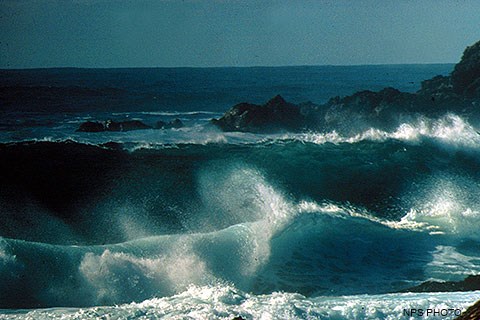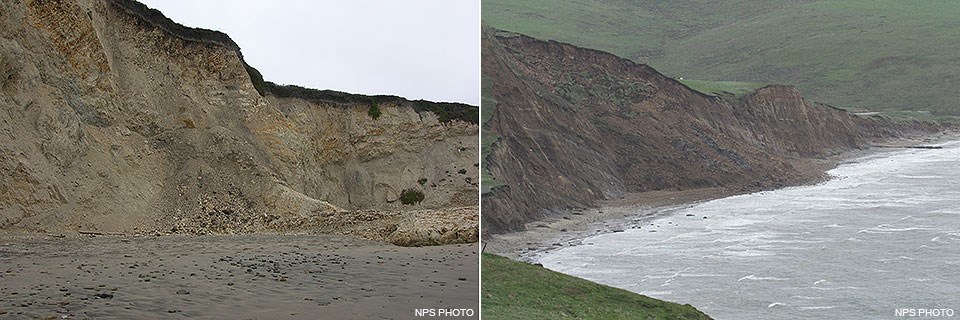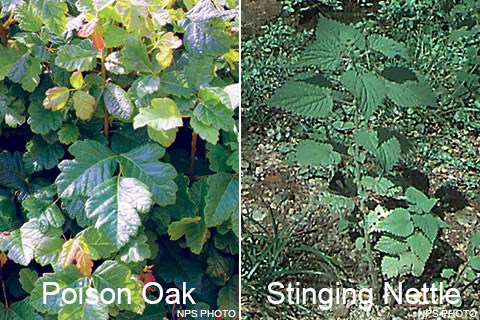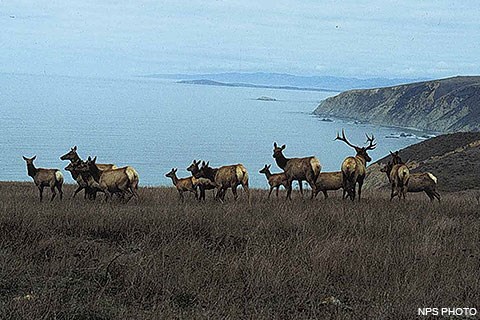|
Many visitors come to Point Reyes to enjoy the beauty of its rugged shoreline and to experience its wildness. Recreating in natural areas, however, has inherent dangers and responsibilities. The information on these pages can help you have a safe and responsible visit so that you, and future visitors, can enjoy the park to its fullest. Beaches | Boating | Cliffs & Rockfalls | Giardia | Hypothermia | Mountain Lions | Phones | Photography | Poison Oak & Stinging Nettle | Ticks | Wildlife | Yellow Jackets 
BeachesThe National Seashore offers a diversity of beaches to explore. However, if you plan to spend any time near the shoreline, stay aware of the movement of the tides. Consult a tide chart before going tidepooling. Always keep an eye on the surf and watch for occasional large waves, called sneaker waves, along Pacific Ocean beaches. Also remember, since fire permits are issued for beach fires, hot coals may exist below the surface if fires have not been extinguished properly. Wearing shoes on beaches is recommended. Following earthquakes, tsunamis may strike the beaches and shorelines of Point Reyes National Seashore. Visit our Safety Issues Associated with Beaches for more information BoatingWhether you are only out for a day-trip or camping overnight on one of Tomales Bay's beaches, there are a number of safety issues about which all boaters should be aware. Nearly every weekend of the year, park rangers, U.S. Coast Guard, and other search-and-rescue personnel are called upon to assist and rescue boaters who haven't properly prepared for their trip or who disregarded hazardous marine weather forecasts. Boaters who have attempted to travel through the waters around Point Reyes National Seashore in unfavorable conditions have died after their vessels capsized. Please visit our Your Safety While Boating page if you plan on boating in the waters around Point Reyes National Seashore. Cliffs and Rockfalls
Many of the cliffs and bluffs found within Point Reyes National Seashore are composed of friable (i.e., easily crumbled or pulverized) rocks and are quite unstable. Rockfalls and landslides occur regularly, so visitors should stay several meters away from the base of the cliffs (as well as from the edge of clifftops). Because of the crumbly nature of the rocks, rock climbing within Point Reyes National Seashore is discouraged. Some of the more prominent collapses or slumps include: GiardiaBeware of giardiasis as the cause of water-borne outbreaks of diarrhea. Associated symptoms include chronic diarrhea, abdominal cramps, bloating, fatigue, and loss of weight. Giardia are carried by humans and some domestic and wild animals. They get into surface water (lakes, streams, and rivers) and contaminate water supplies. Carry water from public supplies in canteens or bulk containers. Note: Check in with the Bear Valley Visitor Center for an up-to-date report on the current water conditions in campgrounds. Call 415-464-5100 x2 x5 seven days a week (except December 25) between 10 am and 4:30 pm. HypothermiaHypothermia can be life threatening! Hypothermia, a condition where body temperatures are lowered followed by rapid and progressive mental and physical collapse, is a year-round threat at Point Reyes. The weather can be highly unpredictable and changes quickly. Even if a summer day begins sunny and warm, cool fog and strong winds can occur later in the day. When you get wet from rain or heavy fog, your body can cool rapidly as moisture evaporates in a breeze. Immersion in cold water can also lead to hypothermia in a relatively short period of time. Please visit our Your Safety: Hypothermia page to learn how to defend against hypothermia and what to do if someone in your party starts to exhibit signs of hypothermia. PhonesReliable AT&T and Verizon cell service is largely limited to the communities of and along the roads connecting Inverness, Inverness Park, Point Reyes Station, and Olema. Cell service elsewhere in the park and by other carriers tends to be extremely limited with weak signals, or nonexistent. Dial 911 or 415-464-5170 in case of an emergency. PhotographyWe want your trip to a national park to be a fun and memorable experience for the whole family! When capturing precious moments, be a smart photographer by: taking your time and sharing the view; keeping your distance from wildlife; and not putting your life at risk for a picture. Visit Keep Safety in the Picture for more details on these tips. 
Poison Oak and Stinging NettleStaying on trails will also help you avoid two plants which can cause annoying skin irritations. Poison oak has three smooth, shiny leaflets and is usually bright green, but often has a red coloration in new shoots and in the dry season. Thoroughly wash any skin that may have come in contact with the plant with cool water and grease-cutting dish soap or poison oak soap. Be sure to also wash all clothing before wearing again. Stinging nettle is a tall weedy plant with needle-like projections that inject a chemical into your skin, creating a burning sensation for up to 24 hours. If you are unsure what either of these plants looks like, stop at a visitor center before starting your hike. Horses can react strongly if they are stung by stinging nettle's small needle-like hairs. Stung horses may begin to panic and leave the trail, thereby moving deeper into the nettles. In extreme cases, horses have died after extensive exposure to this plant. Some trails may be overgrown with nettle at certain times of the year, such as spring and summer. Both horse and rider should avoid this plant. The best way to do this is to stay in the center of the trail. TicksCertain ticks found in the Point Reyes area carry organisms which can infect humans and animals. The prolonged bite of a tick may transmit disease agents which cause Lyme disease, Ehrlichiosis or Babesiosis. Locally, about 1% of adult ticks and 3% of nymphs are found to be infected with the Lyme disease agent. Wearing light-colored, long pants helps you spot ticks and tucking your pant legs inside your socks can help keep them from crawling up your legs. Staying on trails, use of proper outdoor clothing, tick repellants, and thorough and frequent body checks during and following outdoor activity are important measures to prevent tick bites. It is believed that a tick must be attached for more than 24 hours in order to transmit sufficient organisms to cause infection. The quicker ticks are removed, the less the chance of transmittal of the organism that causes illness. Whole ticks can be tested for the presence of the Lyme disease agent as well as other tick-bourne diseases. If you are bitten by a tick while at Point Reyes National Seashore, the tick may be sent to the Sonoma County Department of Health Services Public Health Laboratory for testing. Best results are obtained if the tick is intact, and it is transported in a small bottle or plastic bag along with a water-moistened piece of cotton. The geographic place where the tick is likely to have been encountered and the location on the body where the tick was found attached is important to note in the request for tick testing. If you have questions or would like more information, please contact the Sonoma County Department of Health Services at 707-565-4711. The sooner treatment is initiated, the better the outcome for those exposed to Lyme disease. 
WildlifeWildlife can be unpredictable and dangerous. But visitors to Point Reyes National Seashore need not worry much about being harmed by wildlife if they use a bit of common sense. Always maintain a safe distance of at least 90 meters (300 feet) from large animals such as elk and mountain lions, and at least 23 meters (75 feet) from other wildlife. It is illegal to be within 30 meters (100 feet) of marine mammals. Never position yourself between a bull elk and its harem, a mountain lion and its prey, or an adult and its offspring. Females with young can be especially defensive. Since it can be difficult to determine exactly how far away an animal is, you could also use the "Rule of Thumb for Wildlife Viewing." It is a technique to help ensure you are staying a respectful distance from wildlife. Hold out your arm, raise your thumb, and close one eye. If you cannot block your view of the animal with your thumb, you are probably too close. Use binoculars, spotting scopes or long lenses for close views and photographs. Use an animal’s behavior as a guide to your actions, and limit the time you spend with wildlife. If an animal alters its behavior due to your presence, you are too close. Allow other visitors a chance to enjoy wildlife. If your actions cause an animal to flee, you have deprived other visitors of a viewing opportunity. It is illegal to feed wildlife, including squirrels and birds. Feeding wild animals makes them dependent on people, and these animals sometimes end up biting the hands of people who try to feed them. Diseases and/or parasites may also be transmitted from animals to humans. Do not harass wildlife. Harassment is any human action that causes unusual behavior, or a change of behavior, in an animal. Repeated encounters with people can have negative, long-term impacts on wildlife, including increased levels of stress and the avoidance of essential feeding areas. Mountain LionsMountain lions (also called cougars) live in the park and your paths may cross. Sighting a mountain lion is usually considered a rare treat. Generally, there is no need to fear lions. Ironically, the wild animal that causes more human deaths per year than any other is not the mountain lion, but its primary prey—deer. Your Safety in Mountain Lion Habitat and park visitor centers have information on how to behave in lion habitat and what to do if you should see one in the backcountry. Please report all mountain lion sightings to a ranger at a visitor center. Black BearsBlack bears have begun to repopulate Marin County and have been observed at Point Reyes. Visit our Black Bears in Marin? page for more information. ElkBull elk behave aggressively during their rutting season. Stay on designated trails, where the elk are accustomed to encountering people. If you encounter an elk on the trail, stop and evaluate the situation. Do not approach the elk. Wait for it to proceed on its way. Or you can return to the trailhead. But, as with any potentially dangerous animal, don't completely turn your back on the elk. Keep an eye on it and remain aware of what it is doing. DeerPoint Reyes has an abundance of deer which are often found feeding on the shoulders of roadways. Automobile collisions with deer occur on an almost daily basis. Most of the roads of Point Reyes are windy and narrow, so slow down, observe speed limits and allow your passengers to enjoy the scenery. Yellow JacketsThroughout the year, but especially in late summer and early fall, visitors may encounter yellow jackets at Point Reyes. While a yellow jacket sting for many visitors will only be a temporary, slightly painful irritant, yellow jacket stings can result in a life-threatening situation if the person is allergic to yellow jacket venom. Persons highly sensitive to yellow jacket venom should always carry a sting treatment kit during outdoor activities. Please visit our Your Safety Around Yellow Jackets page to learn more. RabiesParks provide a unique chance to view and appreciate wildlife. However, wildlife can sometimes get sick with diseases that can make you sick too, so respect wildlife from a distance. Rabies is a disease that humans can catch from the bite or saliva of an infected animal. Rabies is always fatal if medical care is not given in time. Any mammal can get rabies, but bats, feral cats, raccoons, foxes, and skunks are more likely to get sick with rabies. Animals sick with rabies may lose their fear of humans, act strangely, or become aggressive. If you are bitten or scratched by an animal, you should immediately see a physician to see if you need medical care to prevent rabies. You cannot tell if an animal has rabies without laboratory testing. Keep yourself safe:
For more information, contact the National Park Service's Veterinary Epidemiologist Dr. Danielle Buttke at 970-267-2118 or by email, or Point Reyes National Seashore's Safety Coordinator Michael Reichmuth at 415-464-5191 or by email. Download the "Rabies: Help us keep you and wildlife safe!" flyer. (383 KB PDF). RoadkillEvery day, wildlife are killed on California's roads and highways, including at Point Reyes. In 1920, noted wildlife biologist Joseph Grinnell observed hundreds of roadkills during his travels along the state's roads and some consider him to have been the first "roadkill observer." In August 2009, the UC Davis Road Ecology Center and the Information Center for the Environment collaboratively developed and distributed the California Roadkill Observation System (CROS). The goal of the CROS is to encourage participation of large numbers of people in both understanding the extent of roadkill and helping develop innovative ideas for reducing roadkill. From August 2009 to July 2010, more than 200 people reported over 6,000 roadkill observations across the majority of the state using the website. Information about where wildlife vehicle collisions occur, what animals are involved, on what kinds of roads are collisions frequent, and other data can help inform policy, management, and financial investment in reducing road-kill. This information can also assist zoologists in identifying the presence or absence of a species throughout the state. You are invited to join the current generation of roadkill observers n their endeavor to accurately describe this important impact of roads and traffic on wildlife in order to come up with ways we can reduce the impact. Feel free to download and read the performance report for CROS's first year's activity, consider logging-in and becoming an observer, and share the web link and report with your colleagues and list-serves. The UC Davis Road Ecology Center and the Information Center for the Environment welcome your feedback on this program, questions, invitations to collaborate, and future participation. |
Last updated: February 5, 2024
